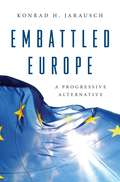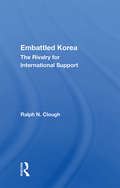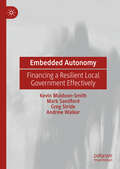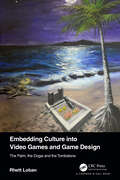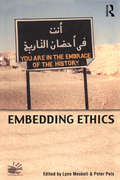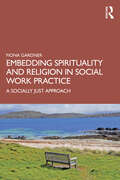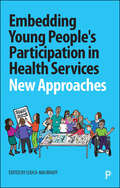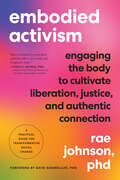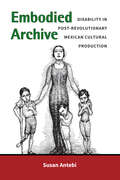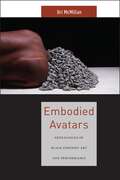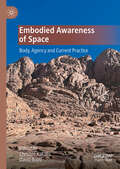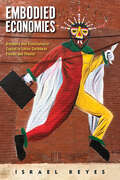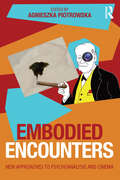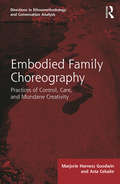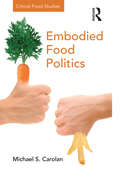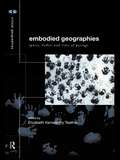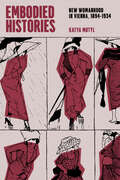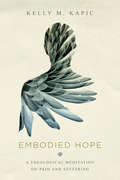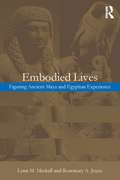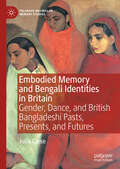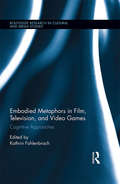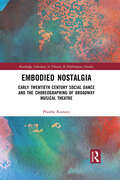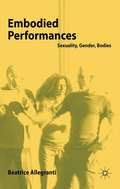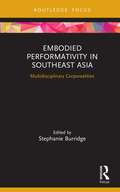- Table View
- List View
Embattled Europe: A Progressive Alternative
by Konrad H. JarauschA bracing corrective to predictions of the European Union’s decline, by a leading historian of modern EuropeIs the European Union in decline? Recent history, from the debt and migration crises to Brexit, has led many observers to argue that the EU’s best days are behind it. Over the past decade, right-wing populists have come to power in Poland, Hungary, and beyond—many of them winning elections using strident anti-EU rhetoric. At the same time, Russia poses a continuing military threat, and the rise of Asia has challenged the EU's economic power. But in Embattled Europe, renowned European historian Konrad Jarausch counters the prevailing pessimistic narrative of European obsolescence with a rousing yet realistic defense of the continent—one grounded in a fresh account of its post–1989 history and an intimate understanding of its twentieth-century horrors.An engaging narrative and probing analysis, Embattled Europe tells the story of how the EU emerged as a model of democratic governance and balanced economic growth, adapting to changing times while retaining its value system. The book describes the EU’s admirable approach to the environment, social welfare, immigration, and global competitiveness. And it presents underappreciated European success stories—including Denmark’s transition to a green economy, Sweden’s restructuring of its welfare state, and Poland’s economic miracle.Embattled Europe makes a powerful case that Europe—with its peaceful foreign policy, social welfare solidarity, and environmental protection—offers the best progressive alternative to the military adventurism and rampant inequality of plutocratic capitalism and right-wing authoritarianism.
Embattled Freedom: Journeys through the Civil War’s Slave Refugee Camps (Civil War America)
by Amy Murrell TaylorThe Civil War was just days old when the first enslaved men, women, and children began fleeing their plantations to seek refuge inside the lines of the Union army as it moved deep into the heart of the Confederacy. In the years that followed, hundreds of thousands more followed in a mass exodus from slavery that would destroy the system once and for all. Drawing on an extraordinary survey of slave refugee camps throughout the country, Embattled Freedom reveals as never before the everyday experiences of these refugees from slavery as they made their way through the vast landscape of army-supervised camps that emerged during the war. Amy Murrell Taylor vividly reconstructs the human world of wartime emancipation, taking readers inside military-issued tents and makeshift towns, through commissary warehouses and active combat, and into the realities of individuals and families struggling to survive physically as well as spiritually. Narrating their journeys in and out of the confines of the camps, Taylor shows in often gripping detail how the most basic necessities of life were elemental to a former slave's quest for freedom and full citizenship.The stories of individuals--storekeepers, a laundress, and a minister among them--anchor this ambitious and wide-ranging history and demonstrate with new clarity how contingent the slaves' pursuit of freedom was on the rhythms and culture of military life. Taylor brings new insight into the enormous risks taken by formerly enslaved people to find freedom in the midst of the nation's most destructive war.
Embattled Korea: The Rivalry For International Support
by Ralph N. CloughThis comprehensive book examines the history of Korea's division and the political and economic development of both Koreas, their military confrontation, and their efforts at dialogue. Mr. Clough focuses on the international rivalry between the two, including relations with big power supporters and diplomatic competition inside and outside the UN and the nonaligned movement. The first book to explore in detail the competition between Seoul and Pyongyang outside the diplomatic circuit—from overseas construction projects to international athletic contests—Mr. Clough's study breaks new ground, analyzing South Korea's growing contacts with the USSR and the PRC, as well as North Korea's relationship with Japan and the United States. He views these contacts as probable precursors of diplomatic recognition of both Koreas by all four big powers. Identifying the problems and the choices for the United States in the rapidly changing environment in and around Korea, Mr. Clough makes recommendations for the future direction of U.S. policy.
Embedded Autonomy: Financing a Resilient Local Government Effectively
by Andrew Walker Kevin Muldoon-Smith Mark Sandford Greg StrideThis book addresses the sustained failure to properly fund local government in England. While there has been plenty of rhetoric and policy initiatives around devolution of power to local authorities in recent decades, continuing recently with the English Devolution Bill, there has been far less attention paid to how these endeavours will be practically delivered and, most importantly, funded. In this context, the motivation in this book is to consider how local government in England could be funded differently. How can the continual hand to mouth existence of local authorities, and those that work to support them, be improved? Drawing on a system-based analysis of international local government practice, the authors develop a new theory of embedded autonomy to help understand and frame how local government can be funded effectively in England.
Embedding Culture into Video Games and Game Design: The Palm, the Dogai and the Tombstone
by Rhett LobanThis book will help game designers and those interested in games thoughtfully embed culture into video games and the game design process. This book raises the issue of how some cultures and communities are misrepresented in various video games. In response to this problem, designers can bring cultural considerations and practices into the centre focus of the game design process. The book advocates that designers put different measures in place to better prevent misrepresentations and engage with deeper understandings of culture to build culturally richer and more meaningful game worlds. The book uses the Torres Strait Virtual Reality project as a primary example, in addition to other game projects, to explore cultural representation in game design. Torres Strait culture is also explored and discussed more broadly throughout the book. No prior knowledge of culture studies is needed, and the book deals with higher level game design with little reference to the technical elements of game development. This unique and timely book will appeal to those interested in the implications of cultural depictions in video games and opportunities to generate deeper cultural representations through the game design process.
Embedding Ethics (Wenner-Gren International Symposium Series)
by Lynn Meskell Peter PelsAnthropologists who talk about ethics generally mean the code of practice drafted by a professional association for implementation by its members. As this book convincingly shows, such a conception is far too narrow. A more radical approach is to recognize that moral judgments are made at every juncture of scientific practice and they require a negotiation of responsibility with all stakeholders in the research enterprise. Embedding Ethics questions why ethics have been divorced from scientific expertise. Invoking different disciplinary practices from biological, archaeological, cultural, and linguistic anthropology, contributors show how ethics should be resituated at the heart of, rather than exterior to, scientific activity. Positioning the researcher as a negotiator of significant truths rather than an adjudicator of a priori precepts enables contributors to relocate ethics in new sets of social and scientific relationships triggered by recent globalization processes - from new forms of intellectual and cultural ownership to accountability in governance, and the very ways in which people are studied. Case studies from ethnographic research, museum display, archaeological fieldwork and professional monitoring illustrate both best practice and potential pitfalls. This important book is an essential guide for all anthropologists who wish to be active contributors to the discussion on ethics and the ethical practice of their profession.
Embedding Spirituality and Religion in Social Work Practice: A Socially Just Approach
by Fiona GardnerBlending material from social work with religious and spiritual sources, this book makes explicit that engaging with spirituality in its broadest sense is an essential aspect of socially just social work practice. Gardner connects shared understandings of spiritual/religious traditions, critically reflective social work, First Nations relational world views, green and relational approaches. Through multiple unique case studies, Embedding Spirituality and Religion in Social Work Practice: A Socially Just Approach outlines the theoretical framework of critical spirituality, which is explored as a way of workers’ understanding their own and others’ sense of meaning, whether it is spiritual and/or religious, and to encourage workers to be mindful, open, humble and energised as workers. Combining the theoretical and practical, this book outlines strategies and processes to ensure social workers embed spirituality in their practice constructively and inclusively across all areas of practice. This book will be of interest to those engaged in the wider field of social work, from direct service to policy development.
Embedding Young People's Participation in Health Services: New Approaches
by Louca-Mai BradyThere is increasing interest in young people’s participation in the design and delivery of health services. But young people’s views are not consistently sought or acknowledged, and they are still often marginalised in healthcare encounters. Drawing on original research and a diverse range of practice examples, Brady explores the potential for inclusive and diverse approaches to young people’s participation in health services from the perspectives of young people, health professionals and other practitioners. She presents a practical new framework, embedded in children’s rights, that shows how young people’s participation can be integrated into services in ways that are meaningful, effective and sustainable.
Embodied Activism: Engaging the Body to Cultivate Liberation, Justice, and Authentic Connection--A Practical Guide for Transformative Social Change
by Rae JohnsonA radically different approach to social and environmental justice work for fans of adrienne maree brown and Bessel van der KolkInstead of thinking about social justice as a process that starts with changing people's minds, Embodied Activism understands our bodies--how we feel in them and relate to others through them--as the sites of transformationHow do ordinary people with busy lives leverage our actions in support of liberation, justice, and authentic connection? How can activists and social change-makers avoid burning out? How does the body factor into what our social movements miss? Drawing on the somatic arts, trauma-informed psychology, and anti-oppressive movements, Embodied Activism helps us explore and transform the political realities of our everyday lives in a new way: by harnessing the felt experience of our bodies as the sites of our activism.Rae Johnson teaches us to listen to our body language--and to question body image norms. They show us how to reconnect to our sensual capacities, which we can lose sight of in a non-stop, nervous-system-hijacking world. They give us tools and exercises to nourish ourselves and protect our bodies, minds, and spirits from the toll that activism can take. And they teach us about nonverbal communication styles and how to connect with each other in joyful, authentic community.Embodied Activism is written for embodiment professionals, community organizers, and all readers looking for new tools and perspectives for changing the world, one body at a time.
Embodied Archive: Disability in Post-Revolutionary Mexican Cultural Production (Corporealities: Discourses Of Disability)
by Susan AntebiEmbodied Archive focuses on perceptions of disability and racial difference in Mexico’s early post-revolutionary period, from the 1920s to the 1940s. In this period, Mexican state-sponsored institutions charged with the education and health of the population sought to strengthen and improve the future of the nation, and to forge a more racially homogeneous sense of collective identity and history. Influenced by regional and global movements in eugenics and hygiene, Mexican educators, writers, physicians, and statesmen argued for the widespread physical and cognitive testing and categorization of schoolchildren, so as to produce an accurate and complete picture of “the Mexican child,” and to carefully monitor and control forms of unwanted difference, including disability and racialized characteristics. Differences were not generally marked for eradication—as would be the case in eugenics movements in the US, Canada, and parts of Europe—but instead represented possible influences from a historically distant or immediate reproductive past, or served as warnings of potential danger haunting individual or collective futures. Weaving between the historical context of Mexico’s post-revolutionary period and our present-day world, Embodied Archive approaches literary and archival documents that include anti-alcohol and hygiene campaigns; projects in school architecture and psychopedagogy; biotypological studies of urban schoolchildren and indigenous populations; and literary approaches to futuristic utopias or violent pasts. It focuses in particular on the way disability is represented indirectly through factors that may have caused it in the past or may cause it in the future, or through perceptions and measurements that cannot fully capture it. In engaging with these narratives, the book proposes an archival encounter, a witnessing of past injustices and their implications for the disability of our present and future.
Embodied Avatars: Genealogies of Black Feminist Art and Performance (Sexual Cultures #5)
by Uri McMillanHow black women have personified art,expression,identity, and freedom through performanceWinner, 2016 William Sanders Scarborough Prize, presented by the Modern Language Association for an outstanding scholarly study of African American literature or cultureWinner, 2016 Barnard Hewitt Award for Outstanding Research in Theatre History, presented by the American Society for Theatre ResearchWinner, 2016 Errol Hill Award for outstanding scholarship in African American theater, drama, and/or performance studies, presented by the American Society for Theatre ResearchTracing a dynamic genealogy of performance from the nineteenth to the twenty-first century, Uri McMillan contends that black women artists practiced a purposeful self-objectification, transforming themselves into art objects. In doing so, these artists raised new ways to ponder the intersections of art, performance, and black female embodiment.McMillan reframes the concept of the avatar in the service of black performance art, describing black women performers’ skillful manipulation of synthetic selves and adroit projection of their performances into other representational mediums. A bold rethinking of performance art, Embodied Avatars analyzes daring performances of alterity staged by “ancient negress” Joice Heth and fugitive slave Ellen Craft, seminal artists Adrian Piper and Howardena Pindell, and contemporary visual and music artists Simone Leigh and Nicki Minaj. Fusing performance studies with literary analysis and visual culture studies, McMillan offers astute readings of performances staged in theatrical and quotidian locales, from freak shows to the streets of 1970s New York; in literary texts, from artists’ writings to slave narratives; and in visual and digital mediums, including engravings, photography, and video art. Throughout, McMillan reveals how these performers manipulated the dimensions of objecthood, black performance art, and avatars in a powerful re-scripting of their bodies while enacting artful forms of social misbehavior.The Critical Lede interview with Uri McMillan
Embodied Awareness of Space: Body, Agency and Current Practice
by David Boyd Christos KakalisThis edited volume explores the notion of embodied experience through a diverse range of disciplines: architecture, music, literature, performance studies, philosophy, geopolitics. In doing so, it illuminates the need to redefine the role of the human body as one of the protagonists for raising awareness of space-time issues through processing, experimentation and application of histories and theories of embodied awareness of space. Critically revisiting these spatio-temporal dialogues, this book suggests a method of linking theory, history and practice: past, present and future. The authors reinstate the significance of history and theory in creative thinking, and test their applicability in a number of different areas: theoretical and buildable architectural projects, mapping and geography, representation, and performative arts. This volume will appeal to students and scholars from architecture, art, cultural studies, landscape studies, media studies, and other disciplines in the humanities and social sciences.
Embodied Economies: Diaspora and Transcultural Capital in Latinx Caribbean Fiction and Theater (Latinidad: Transnational Cultures in the United States)
by Israel ReyesHow do upwardly mobile Latinx Caribbean migrants leverage their cultural heritage to buy into the American Dream? In the neoliberal economy of the United States, the discourse of white nationalism compels upwardly mobile immigrants to trade in their ties to ethnic and linguistic communities to assimilate to the dominant culture. For Latinx Caribbean immigrants, exiles, and refugees this means abandoning Spanish, rejecting forms of communal inter-dependence, and adopting white, middle-class forms of embodiment to mitigate any ethnic and racial identity markers that might hinder their upwardly mobile trajectories. This transactional process of acquiring and trading in various kinds of material and embodied practices across traditions is a phenomenon author Israel Reyes terms “transcultural capital,” and it is this process he explores in the contemporary fiction and theater of the Latinx Caribbean diaspora. In chapters that compare works by Lin-Manuel Miranda, Nilo Cruz, Edwin Sánchez, Ángel Lozada, Rita Indiana Hernández, Dolores Prida, and Mayra Santos Febres, Reyes examines the contradictions of transcultural capital, its potential to establish networks of support in Latinx enclaves, and the risks it poses for reproducing the inequities of power and privilege that have always been at the heart of the American Dream. Embodied Economies shares new perspectives through its comparison of works written in both English and Spanish, and the literary voices that emerge from the US and the Hispanic Caribbean.
Embodied Encounters: New approaches to psychoanalysis and cinema
by Agnieszka PiotrowskaWhat is the role of the unconscious in our visceral approaches to cinema? Embodied Encounters offers a unique collection of essays written by leading thinkers and writers in film studies, with a guiding principle that embodied and material existence can, and perhaps ought to, also allow for the unconscious. The contributors embrace work which has brought ‘the body’ back into film theory and question why psychoanalysis has been excluded from more recent interrogations. The chapters included here engage with Jung and Freud, Lacan and Bion, and Klein and Winnicott in their interrogations of contemporary cinema and the moving image. In three parts the book presents examinations of both classic and contemporary films including Black Swan, Zero Dark Thirty and The Dybbuk: Part 1 – The Desire, the Body and the Unconscious Part 2 – Psychoanalytical Theories and the Cinema Part 3 – Reflections and Destructions, Mirrors and Transgressions Embodied Encounters is an eclectic volume which presents in one book the voices of those who work with different psychoanalytical paradigms. It will be essential reading for psychoanalysts and psychotherapists, scholars and students of film and culture studies and film makers.
Embodied Family Choreography: Practices of Control, Care, and Mundane Creativity (Directions in Ethnomethodology and Conversation Analysis)
by Asta Cekaite Marjorie Harness GoodwinEmbodied Family Choreography documents the lived and embodied practices employed to establish, maintain, and negotiate intimate social relationships in the family, examining forms of control, care, and creativity. Making use of the extensive video archives of family interaction in the US and Sweden, it presents the first investigation of how touch and interaction between bodies, in conjunction with talk, constitute a primary means of orchestrating activities through directives, thus creating rich relationships through supportive interchanges, and engaging in playful explorations of the world. Through close investigation of the sequential and simultaneous engagement of bodies interacting with other bodies, this book makes visible the important role touch plays in the context of contemporary Western middle class family life and is pioneering in its analysis of how the visual, aural, and haptic senses (usually analysed separately) mutually elaborate one another. As such, Embodied Family Choreography will appeal to scholars of child development, the sociology of the family and ethnomethodology and conversation analysis.
Embodied Food Politics (Critical Food Studies)
by Michael S. CarolanWhile the phenomenon of embodied knowledge is becoming integrated into the social sciences, critical geography, and feminist research agendas it continues to be largely ignored by agro-food scholars. This book helps fill this void by inserting into the food literature living, feeling, sensing bodies and will be of interest to food scholars as well as those more generally interested in the phenomenon known as embodied realism. This book is about the materializations of food politics; "materializations", in this case, referring to our embodied, sensuous, and physical connectivities to food production and consumption. It is through these materializations, argues Carolan, that we know food (and the food system more generally), others and ourselves.
Embodied Geographies (Critical Geographies)
by Elizabeth Kenworthy TeatherEmbodied Geographies provides a comprehensive account of different types of life crises which develop our identities and affect how we live our lives. Chapters focus on:* pregnancy, childbirth, teenagers and parenthood* migration* the threat and reality of violence* illness and disability* bereavement, the ensuing family responsibilities and death itself.It includes case studies from the UK, Australia, New Zealand, Singapore, Hong Kong, Canada and the USA.
Embodied Histories: New Womanhood in Vienna, 1894–1934
by Katya MotylExplores the emergence of a new womanhood in turn-of-the-century Vienna. In Embodied Histories, historian Katya Motyl explores the everyday acts of defiance that formed the basis for new, unconventional forms of womanhood in early twentieth-century Vienna. The figures Motyl brings back to life defied gender conformity, dressed in new ways, behaved brashly, and expressed themselves freely, overturning assumptions about what it meant to exist as a woman. Motyl delves into how these women inhabited and reshaped the urban landscape of Vienna, an increasingly modern, cosmopolitan city. Specifically, she focuses on the ways that easily overlooked quotidian practices such as loitering outside cafés and wandering through city streets helped create novel conceptions of gender. Exploring the emergence of a new womanhood, Embodied Histories presents a new account of how gender, the body, and the city merge with and transform each other, showing how our modes of being are radically intertwined with the spaces we inhabit.
Embodied Hope: A Theological Meditation on Pain and Suffering
by Kelly M. Kapic"This book will make no attempt to defend God. . . . If you are looking for a book that boasts triumphantly of conquest over a great enemy, or gives a detached philosophical analysis that neatly solves an absorbing problem, this isn't it."Embodied Hope
Embodied Lives: Figuring Ancient Maya and Egyptian Experience
by Rosemary A. Joyce Lynn M. MeskellExamining a wide range of archaeological data, and using it to explore issues such as the sexual body, mind/body dualism, body modification, and magical practices, Lynn Meskell and Rosemary Joyce offer a new approach to the Ancient Egyptian and Mayan understanding of embodiment. Drawing on insights from feminist theory, art history, phenomenology, anthropology and psychoanalysis, the book takes bodily materiality as a crucial starting point to the understanding and formation of self in any society, and sheds new light on Ancient Egyptian and Maya cultures. The book shows how a comparative project can open up new lines of inquiry by raising questions about accepted assumptions as the authors draw attention to the long-term histories and specificities of embodiment, and make the case for the importance of ancient materials for contemporary theorization of the body. For students new to the subject, and scholars already familiar with it, this will offer fresh and exciting insights into these ancient cultures.
Embodied Memory and Bengali Identities in Britain: Gender, Dance, and British Bangladeshi Pasts, Presents, and Futures (Palgrave Macmillan Memory Studies)
by Julia GieseThis book provides insight into the relationship between embodied processes and products of remembering and belonging among British Bangladeshi women in Tower Hamlets, London. Based on an analysis of memories performed in both professional and social dancing among British Bangladeshi women, as well as of the spaces and encounters that enable the production, transmission, and negotiation of such memories, this book addresses questions about the relationship between remembering and identification in the diaspora.
Embodied Metaphors in Film, Television, and Video Games: Cognitive Approaches (Routledge Research in Cultural and Media Studies)
by Kathrin FahlenbrachIn cognitive research, metaphors have been shown to help us imagine complex, abstract, or invisible ideas, concepts, or emotions. Contributors to this book argue that metaphors occur not only in language, but in audio visual media well. This is all the more evident in entertainment media, which strategically "sell" their products by addressing their viewers’ immediate, reflexive understanding through pictures, sounds, and language. This volume applies cognitive metaphor theory (CMT) to film, television, and video games in order to analyze the embodied aesthetics and meanings of those moving images.
Embodied Nostalgia: Early Twentieth Century Social Dance and the Choreographing of Broadway Musical Theatre (Routledge Advances in Theatre & Performance Studies)
by Phoebe RumseyEmbodied Nostalgia is a collection of interlocking case studies that focus on how social dance in musical theatre brings forth the dancer on stage as a site of embodied history, cultural memory, and nostalgia, and asks what social dance is doing performatively, dramaturgically, and critically in musical theatre. The case studies in this volume are all Broadway musicals set during the Jazz Age (1910-1950), however, performed and produced after that time, creating a spectrum of nostalgic impulses that are interrogated for social and political resonance and meaning. All reflect the fractures or changes in the social dance when brought to the stage and expose the complexities of the embodied nostalgia – broadly interpreted as the physicalizing of community memories, longings, and historical meaning – the dances carry with them. Particular attention is focused on the Black ownership of the social dances and the subsequent appropriation, cultural theft, and forgotten legacies. By approaching musical theatre through this lens of social dance––always already deeply connected to notions of class and race––and the politics of choreography therein, a unique and necessary method to describing, discussing, and critically evaluating the body in motion in musical theatre is put forth.
Embodied Performances
by Beatrice AllegrantiDrawing from the author's unique interdisciplinary experience Embodied Performances, now available in paperback, responds to the feminist call for advances in conversations across disciplines. Through a pioneering integration of performance, psychotherapy and feminist philosophy it offers an understanding and critique of embodiment and proposes expansive ways of deconstructing (undoing) and re-constituting (re-doing) sexuality and gender and thus more embodied and ethical ways of 'doing' life. Embodied Performances presents innovative ways of 'knowing' and 're-visioning' which evolves the contemporary zeitgeist by: allying digital media with established forms and considering the socially constructed and biological body at the forefront of theory and practice in both the arts and humanities. In addition, it provides practice-based evidence in the form of thirty-six short online film episodes and stills, forming an integral part of the unfolding discussion in each chapter.
Embodied Performativity in Southeast Asia: Multidisciplinary Corporealities (Routledge Contemporary Southeast Asia Series)
by Stephanie BurridgeA collection presenting cutting edge research from music, dance, performance art, fashion and visual arts, written by scholar-practitioners working in Southeast Asia. This eclectic monograph explores multi-disciplinarily performativity through the body. Exploring the notion of the body as central to creative practice it draws together conversations centring on innovation through embodied knowledge relating to space, time and place. The authors in this collection are leaders in their field and recognized internationally. Their chapters represent new directions in thought and practice by game-changers in the arts. Underpinned by a central theme of corporeality, it is bold and innovative in its scope and range, bringing diverse disciplines together. It enables connections that create new ways of critically exploring corporeality extending beyond physicality and the traditional body-centred areas of performing arts practice. Insightful and stimulating reading for students, scholars and practitioners across the tertiary arts sector, as well as education, therapy, cultural studies and interdisciplinary arts.
